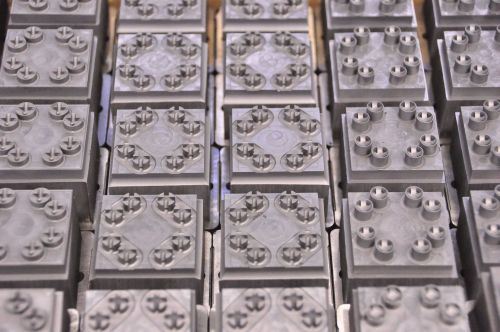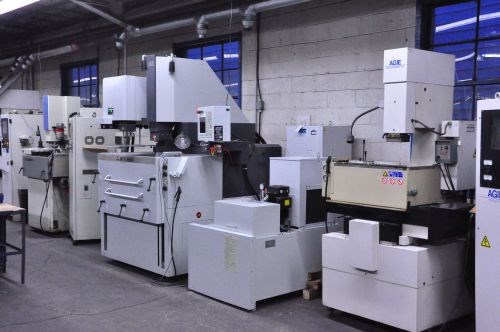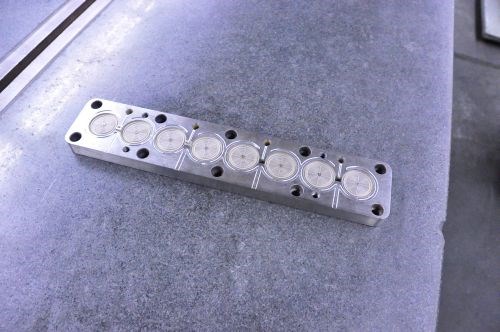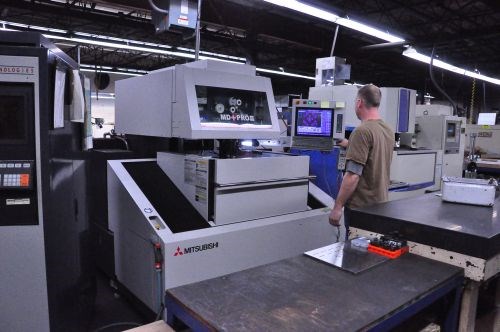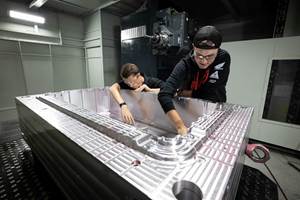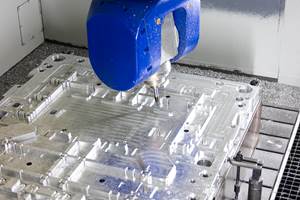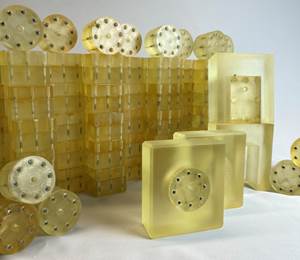EDM Upgrades Enable Faster, Smarter Burns
Intuitive operation, “intelligent” control features, energy savings and raw performance were among the factors driving this shop’s choice of new sinker and wire EDM machines.
Toolmakers often harp on the importance of combining deep knowledge and high technology, and Depew, New York-based Moldcraft is no exception. Yet, the shop’s most recent sinker EDM purchase blurs the lines between these twin drivers of growth and success. Featuring an intuitive programming interface and a power supply that adapts to cutting conditions, the Mitsubishi EA12D from MC Machinery Systems is designed to deliver high performance regardless of the operator’s skill level.
Of course, the machine also provides the raw speed and accuracy that Moldcraft’s leadership had come to expect after their previous experience with that builder’s equipment, particularly an MV1200-S wire EDM. Purchased just a few months prior to the sinker, this wire machine offered the added benefit of substantially reducing operating costs compared to the model it replaced. Given the performance of both machines, Moldcraft will likely turn to Mitsubishi again as it continues to phase out old equipment for new, says co-owner Jimmy Gray.
Seeking Capacity
Like the recent EDM purchases, these future acquisitions will be driven largely by the growing shop’s need for additional capacity. Moldcraft has been “quite busy” during the past three years, Gray explains, citing high demand for on-time delivery, consistently high quality, and competitive pricing among the company’s automotive, consumer product and electronics industry customers. The 40-year-old shop owes its reputation for delivering on these requirements to the knowledge and skill of its 13 certified moldmakers and engineers, he says. Their expertise, along with his own and that of fellow co-owners John Chase and Henry Lewandowski, also enables Moldcraft to pursue difficult work that other shops might avoid.
Still, efficiently processing tools involving contoured parting lines, difficult part-ejection scenarios, insert overmolding and other challenges requires not just the right knowledge, but also the right technology. Tolerances on most of the shop’s work, which consists of 90- to 500-ton injection molds, silicon molds, blow molds, and rubber compression and transfer molds, are best measured in tenths. Although such precision is well within the range of the 12,000-square-foot shop’s capabilities, aging machinery and an increased workload has led Gray and his team to consider newer technology that promises faster production at reduced cost.
Quicker Burns, Less Waste
Wire EDM was among the most pressing capacity needs until last spring, when Moldcraft took delivery of the MV1200-S. Among the most notable features is the machine’s cylindrical drive technology (CDT) motion system, which greatly reduces power consumption. This technology employs linear shaft motors that operate according to the same basic principles as other linear motor designs—that is, a moving element is pulled along a stationary element via magnetic force, with a slight gap between the two. However, rather than the flat plates typical of many designs, the moving and stationary elements of linear shaft motors are cylindrical and fit together similarly to the parts of a telescope. According to the manufacturer, wrapping the hollow moving element (lined with electromagnetic coils) 360 degrees around the stationary shaft (embedded with permanent magnets) ensures full use of the available magnetic flux, much of which radiates away in flat-plate configurations.
The machine reduced consumable costs as well. That’s thanks to a power supply finishing circuit that reduces wire consumption. According to the manufacturer, combining these savings with energy-use reductions from the CDT system reduces the wire EDM’s overall operating costs by as much as 42 percent compared to its previous-generation FA series machine.
Moldcraft also reports that savings extend beyond just operating costs. When Gray first consulted with Millenium Machinery, the Rochester, New York-based MC Machinery distributor that supplied the EDM, he asked what cycle time savings he might expect from a new machine. Frank Maehr, president of Millenium, estimated that, compared to the shop’s aging FX-20K, a modern EDM might deliver 10- to 15-percent faster cutting speeds. Everyone was pleasantly surprised when the MV1200-S exceeded his expectations. “Jimmy called me shortly after it was installed and said it was running around 40-percent faster,” Maehr recalls. “He was so pleased, he started asking me about a new sinker right off.”
Built-in Intelligence
Although Moldcraft had considerable sinker capability at the time, some of its mixed selection of EDM brands and models were more than a decade old, Gray says. As workload increased, so did the bottlenecks, and he and the rest of the team were hopeful that a newer, more capable machine would help. The EA12D didn’t disappoint.
Like the MV1200-S, the new sinker machine proved substantially faster than Moldcraft’s legacy equipment. That’s due primarily to the EA12D’s 80-amp, FP60 fine-pulse power supply. Along with Mitsubishi’s Fuzzy Pro Plus burn logic, the FP60 dynamically adjusts power settings to optimize roughing without losing finishing capability.
Maehr says this capability enables the machine to operate in a way that could be described as intelligent. When most EDM machines run into trouble, say on a deep rib or long-aspect-ratio burn, they immediately back off the power, he explains. This significantly reduces cutting speed in difficult burn conditions. The Mitsubishi, on the other hand, automatically adjusts burn parameters until it gets itself out of trouble. It then becomes more aggressive to regain any time lost in tough areas of the burn—the same approach a skilled operator might take.
Another example of “smart” operation is the EDM’s ESPER programming system. After entering basic parameters to define the part shape and electrode, operators tell the system whether to prioritize speed, surface finish or wear. Based on this input, the system chooses the right burn model to achieve the desired results. “ESPER allows even non-EDM people to operate an EDM, and it gives skilled operators the ability to take the machine further than was previously possible,” Maehr says.
Along with a large work tank (41.3 by 27.5 by 17.7 inches), standardized workholding (the shop uses Macro chucks from System 3R) and a 20-electrode changer, this control intelligence is particularly useful for lights-out runs, Gray reports. He adds that the team can fully rely on its accuracy and surface finish capabilities. “Compared to our other sinkers, the EA12D showed a huge improvement in overall part quality,” he says.
Related Content
Hybrid Milling/Drilling Machine Reduces Total Mold Machining Time
MSI Mold Builders now squares, plus drills and taps eye-bolt holes on 50% of its tools in a single setup using a five-axis milling/drilling center with a universal spindle.
Read MoreFive-Axis Vertical Mill Increases Mold Shop Capacity by Reducing Setups
Zero Tolerance now processes blocks — from squaring to waterline drilling to rough and finish milling — on a single five-axis CNC mill, reducing setups and moving blocks in/out of multiple machines without sacrificing accuracy and surface finish.
Read MoreTrue Five-Axis Machine Yields More Throughput, Greater Productivity
CDM Tool & Mfg. Co. LLC increased shop capacity thanks to a versatile high-speed/high-accuracy five-axis Fooke mill capable of cutting very large workpieces quickly and accurately with fewer setups.
Read MoreIn "Hybrid" FIM Process, 3D Printing Complements Injection Molding
Alpine Advanced Materials used a desktop 3D printer and the freeform injection molding process to reduce prototype tooling production time and cost for its customers.
Read MoreRead Next
Are You a Moldmaker Considering 3D Printing? Consider the 3D Printing Workshop at NPE2024
Presentations will cover 3D printing for mold tooling, material innovation, product development, bridge production and full-scale, high-volume additive manufacturing.
Read MoreHow to Use Strategic Planning Tools, Data to Manage the Human Side of Business
Q&A with Marion Wells, MMT EAB member and founder of Human Asset Management.
Read MoreReasons to Use Fiber Lasers for Mold Cleaning
Fiber lasers offer a simplicity, speed, control and portability, minimizing mold cleaning risks.
Read More
